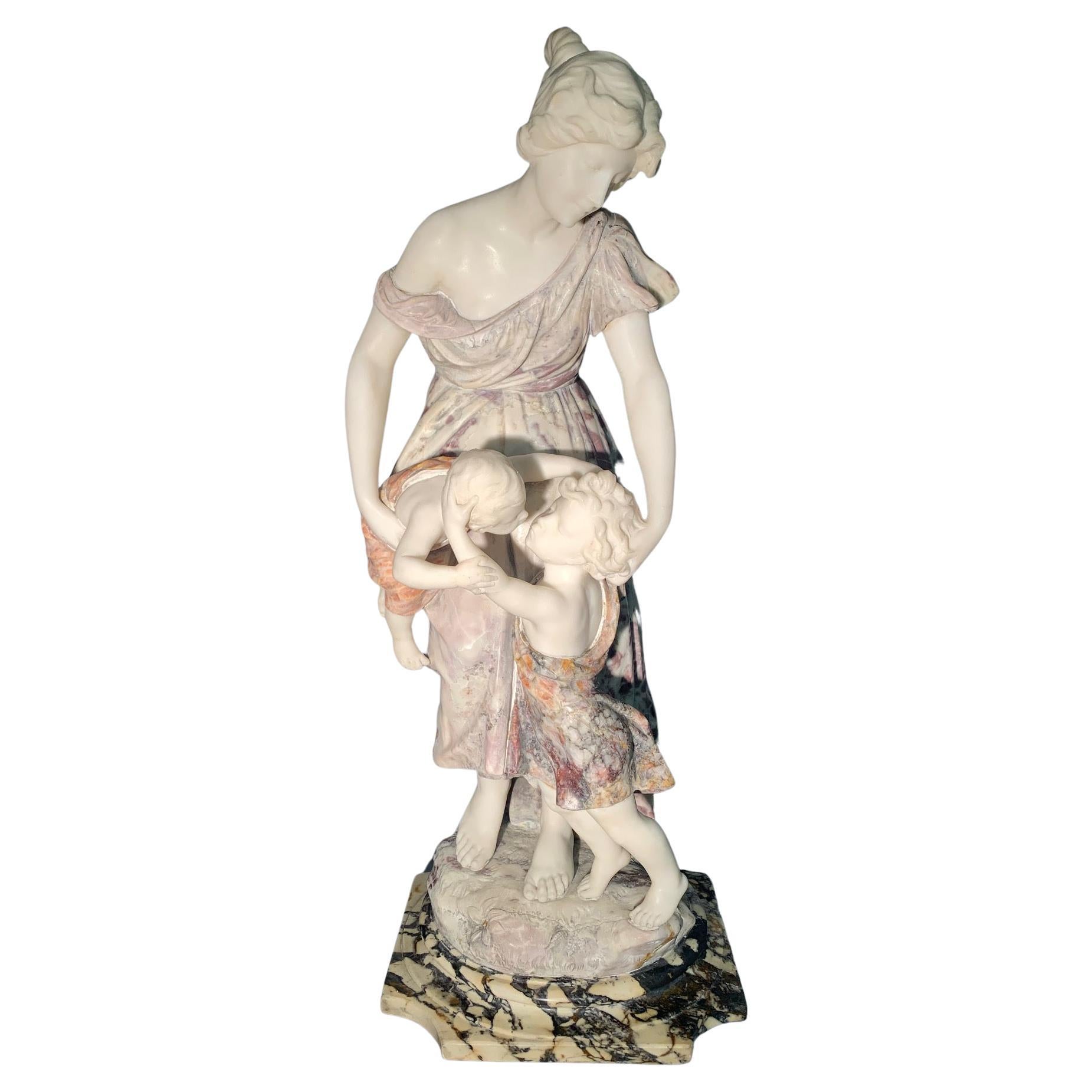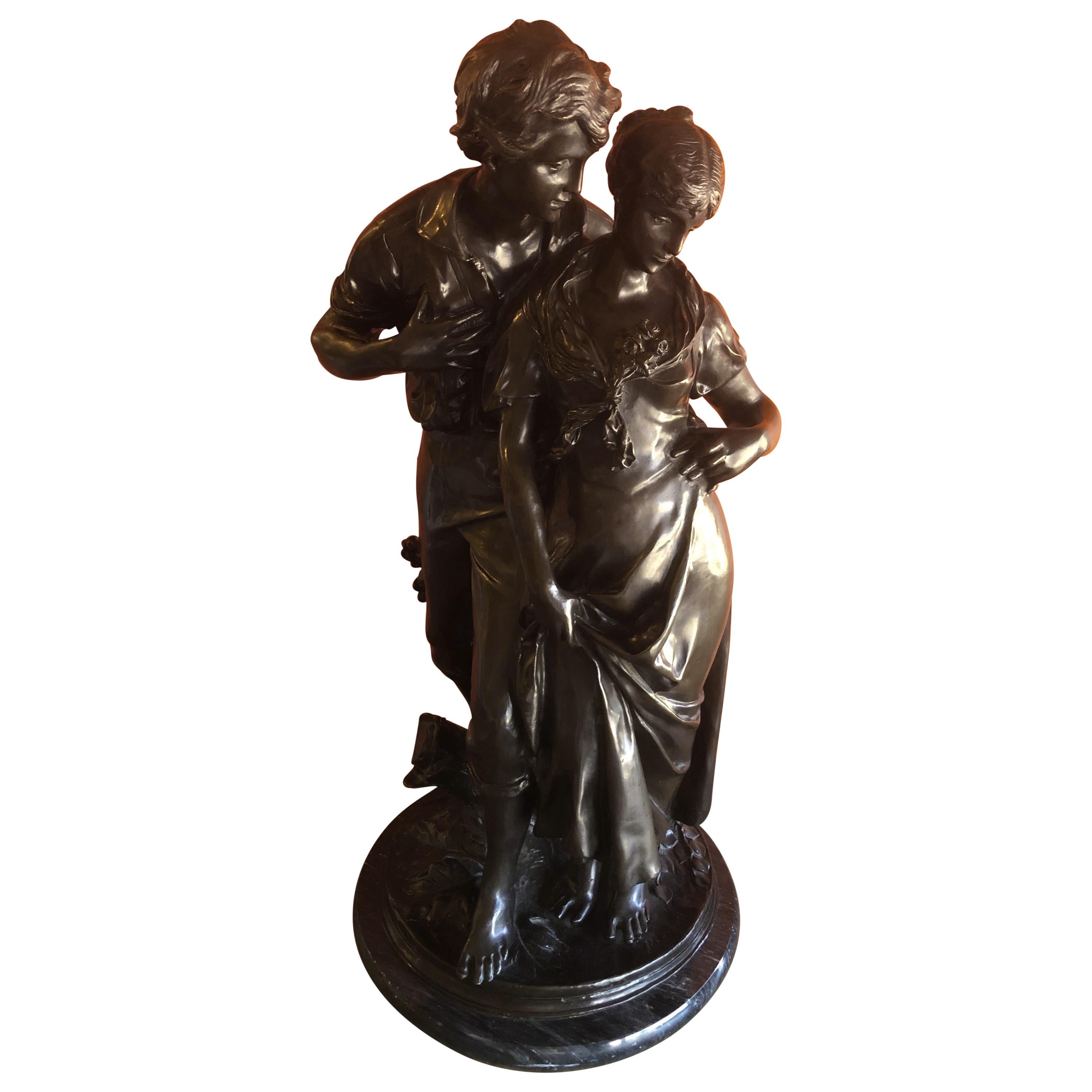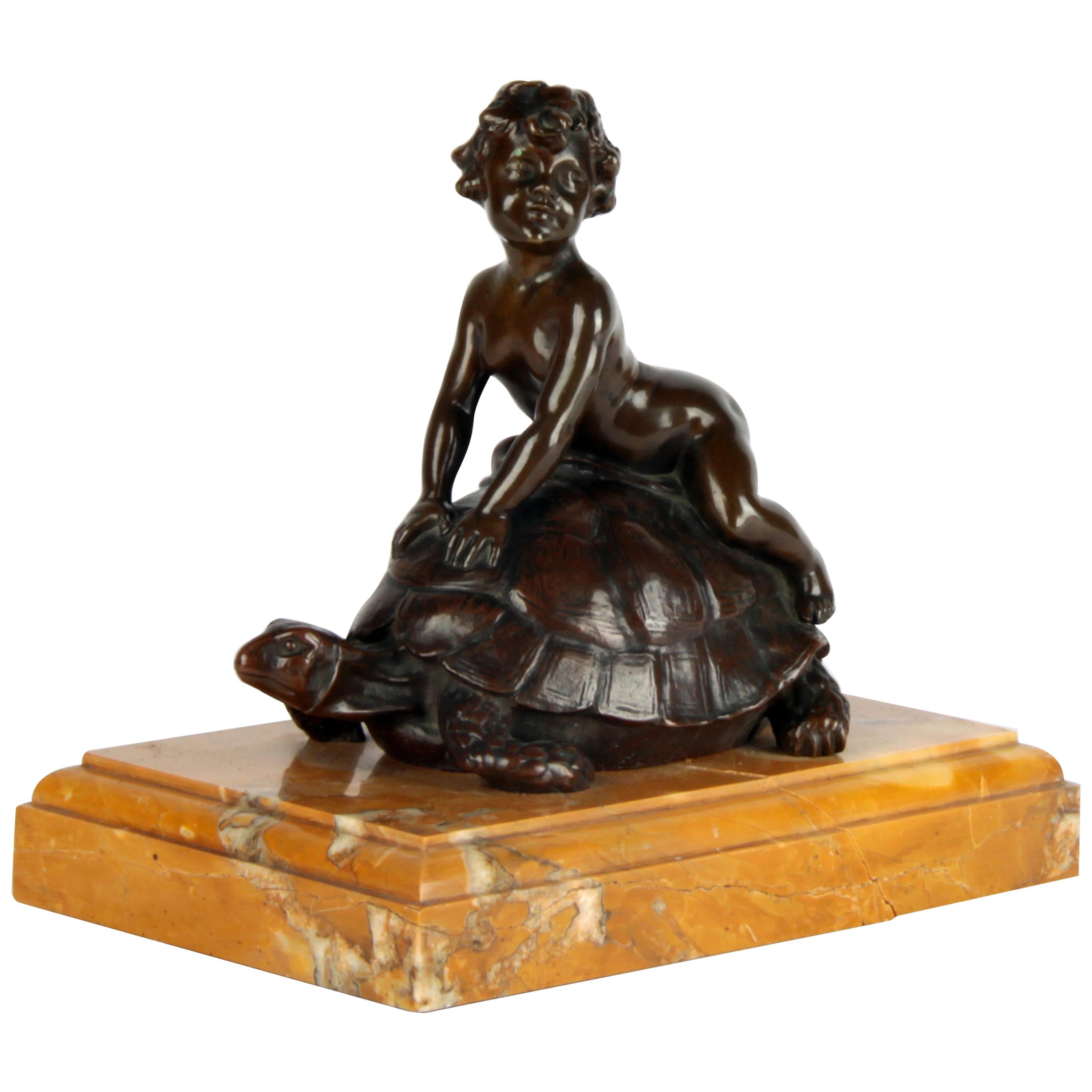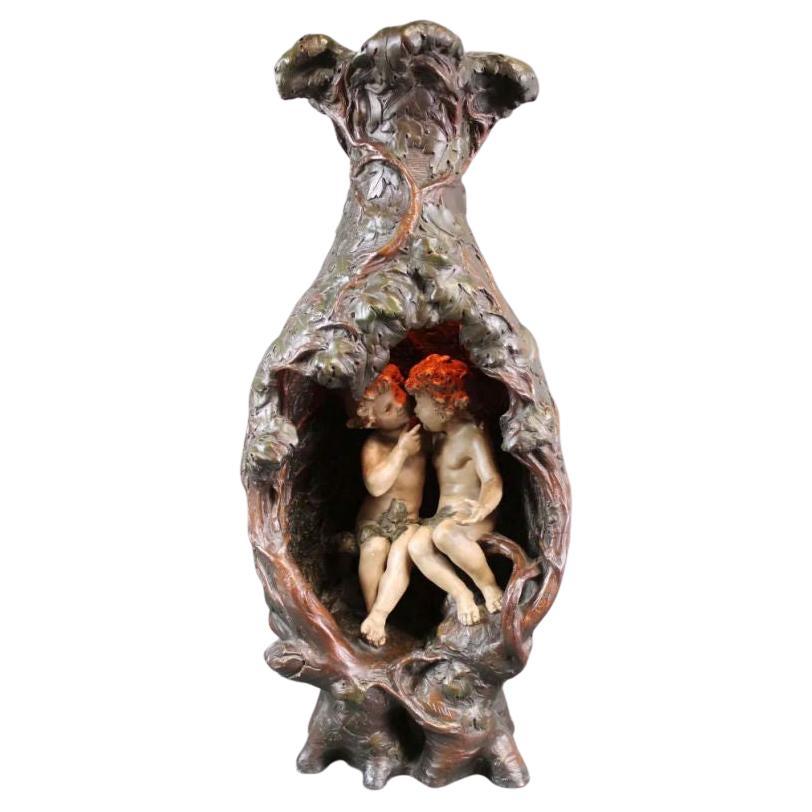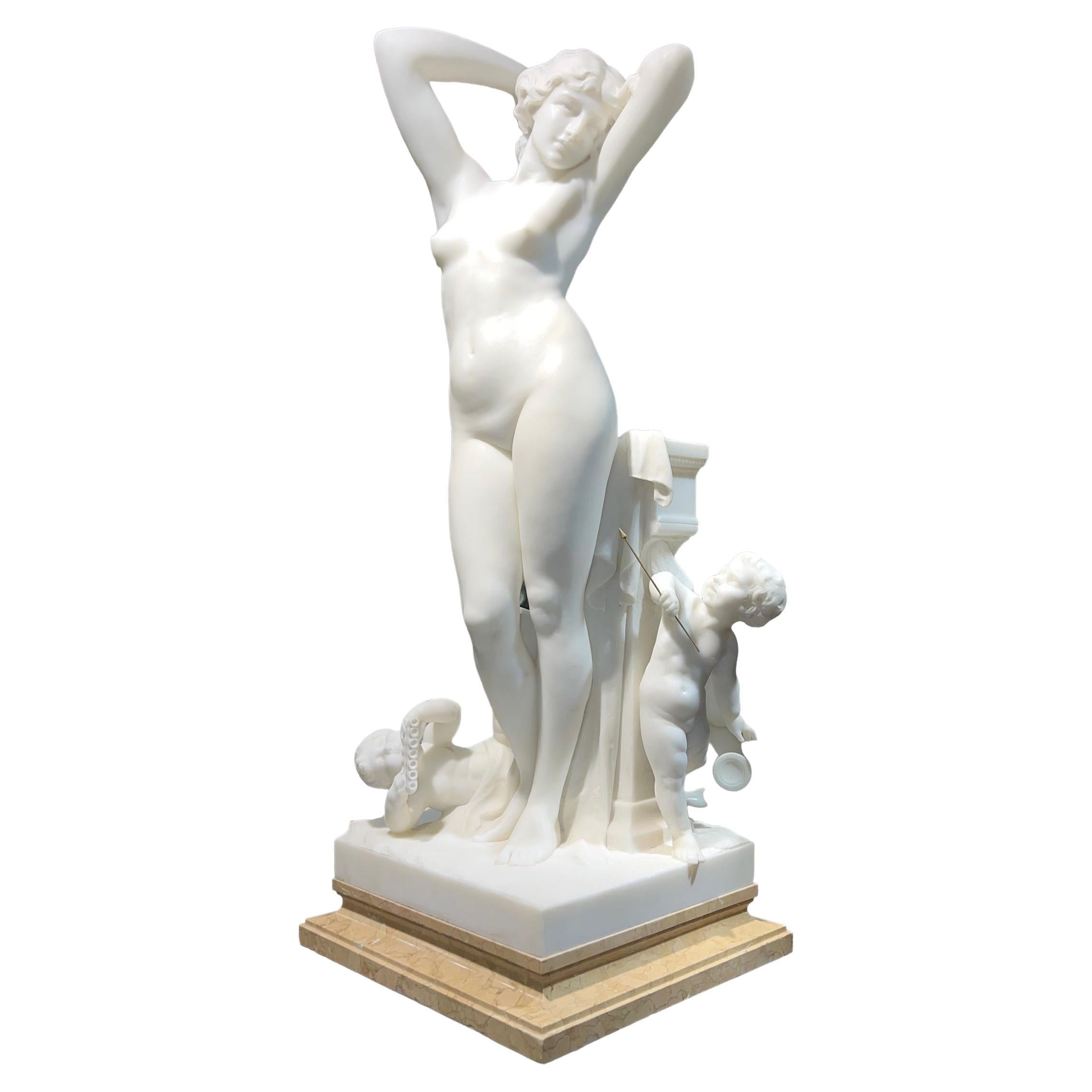Items Similar to French 19th/20th Century Bronze of a Fairy “Lutin des Bois”, After Luca Madrassi
Want more images or videos?
Request additional images or videos from the seller
1 of 21
French 19th/20th Century Bronze of a Fairy “Lutin des Bois”, After Luca Madrassi
About the Item
A Fine French 19th/20th Century Patinated Bronze Figure titled “Lutin des Bois” (Woodland Fairy or Elf) after Luca Madrassi (Italian, 1869-1914). The beautifully executed slender figure of a nude fairy, in a brown patina, wrapped with a loose scarf, standing atop a rock formation with flowers and flanked by a pair of kissing Love doves. Signed 'Madrassi – Paris’ raised on a gilt-bronze circular plinth. A bronze plaque reads "Lutin des Bois - Par Madrassi (Médaille au Salon)". Circa: Paris, 1900.
Luca Madrassi (Italian, 1869-1914) was an Italian-born French artist best known for his bronze Art Nouveau sculptures of mythological, allegorical, and rustic figures. His work was influenced by the famed French illustrator and sculptor Gustave Doré.
Height: 32 3/4 inches (83.2 cm)
Width: 16 inches (40.7 cm)
Depth: 12 3/4 inches (32.4 cm)
Circular Base Diameter: 8 1/2 inches (21.6 cm)
- Creator:Luca Madrassi (Sculptor)
- Dimensions:Height: 32.75 in (83.19 cm)Width: 16 in (40.64 cm)Depth: 12.75 in (32.39 cm)
- Style:Belle Époque (Of the Period)
- Materials and Techniques:
- Place of Origin:
- Period:1900-1909
- Date of Manufacture:Circa: Paris, 1900
- Condition:Refinished. Wear consistent with age and use. Minor fading. A truly beautiful and charming sculpture. Overall current condition is great, the patina has been refreshed and waxed, minor age nicks and wear. Please view all images.
- Seller Location:Los Angeles, CA
- Reference Number:
About the Seller
5.0
Vetted Seller
These experienced sellers undergo a comprehensive evaluation by our team of in-house experts.
Established in 1982
1stDibs seller since 2016
113 sales on 1stDibs
Typical response time: <1 hour
- ShippingRetrieving quote...Ships From: Los Angeles, CA
- Return PolicyThis item cannot be returned.
More From This SellerView All
- French 19th-20th Century Art-Nouveau Bronze Patinated Bust of Marie AntoinetteBy Agathon LéonardLocated in Los Angeles, CAA fine French 19th-20th century Art-Nouveau patinated bronze bust of "Marie Antoinette" (Queen of France 1755-1793), after the model by Agathon Léonard or Léonard Agathon van Weydeve...Category
Antique Early 1900s French Art Nouveau Busts
MaterialsBronze
- After Gaston Leroux French 19th Century Bronze Sculpture of RebeccaBy Gaston Veuvenot LerouxLocated in Los Angeles, CAA fine French 19th-20th century orientalist silvered and gilt patinated bronze sculpture of "Rebecca" with a plaque that reads "Jeune Fille Arabe" (A Young Arab Girl - Water-Carrier)...Category
Antique Early 1900s French Greco Roman Figurative Sculptures
MaterialsBronze
- Pair French 19th/20th Century Gilt-Bronze Sculptures of The Marly Horses LampsBy Guillaume CoustouLocated in Los Angeles, CAA Fine Pair of French 19th/20th Century Gilt-Bronze Sculptures of "The Marly Horses" (Now turned into lamps) After the original by Guillaume Coustou (French, 1677-1746). The large pair of equestrian bronze sculptures, finished in a gold patina, each depicting rearing horses with their groom, both raised on oval a black slate and Bardiglio marble bases and fitted with modern electrical twin-light brass fittings and cream colored shades. The base on an ebonized wooden platform. Circa: Paris, 1900-1920. Sculpture & Base Height: 31 1/4 inches (79.8 cm) Base Width: 21 3/4 inches (55.3 cm) Base Depth: 12 3/4 inches (32.4 cm) Height to top of (Adjustable) shade fitting: 48 1/4 inches (122.6 cm) Shade Height: 15 inches (38.1 cm) Shade Width: 26 inches (66.1 cm) Shade Depth: 20 inches (50.8 cm) The original Marly Horses are two 1743–1745 Carrara marble sculpted groups by Guillaume Coustou. They were commissioned by Louis XV of France for the trough at the entrance to the grounds of his château de Marly. Coustou's last works, they were intended to replace two other sculpted groups, Mercury on Pegasus and Pegasus, Renown of Horses, both by Antoine Coysevox, which had been removed to the Tuileries Gardens in 1719. Louis XV chose the modellos in 1743 and the full-size sculptures were completed in only two years, being installed at Marly in 1745. They proved highly successful in reproduction, particularly on a smaller scale, and prefigured Théodore Géricault and other Romantic artists' obsession with equestrian subjects. The Marly horses were later also used as the central motif of the monochrome 819-line RTF/ORTF test card which was used on TF1 from 1953 until 1983. The originals were moved to the place de la Concorde in Paris in 1794 and Louis-Denis Caillouette (1790–1868) restored them in 1840. In 1984 it was concluded that the annual military parades on 14 July were damaging the sculptures and they were replaced by marble copies produced by Michel Bourbon in the studio of a subsidiary of Bouygues. The latter also gained the right to an extra copy, which was placed in Bouygues's social building. The original sculptures were moved to a former courtyard in the Richelieu wing of the Louvre Museum, which was renamed the 'cour Marly' in their honour, whilst Bourbon's two main copies were moved to the originals' first site near the trough at Marly, with work overseen by the architect Serge Macel. Guillaume Coustou the Elder (29 November 1677, Lyon – 22 February 1746, Paris) was a French sculptor of the Baroque and Louis XIV style. He was a royal sculptor for Louis XIV and Louis XV and became Director of the Royal Academy of Painting and Sculpture in 1735. He is best known for his monumental statues of horses made for the Chateau of Marly, whose replicas now stand in the Place de la Concorde in Paris. Coustou was a member of a family of famous sculptors; his uncle, Antoine Coysevox, was a royal sculptor; his elder brother, Nicolas Coustou was a sculptor, and his son Guillaume Coustou the Younger also become a noted royal sculptor. Like his older brother, he won the (Prix de Rome) of the Royal Academy which entitled him to study for four years at the French Academy in Rome. However, he refused to accept the discipline of the academy, gave up his studies, set out to make his own career as an artist. He worked for a time in the atelier of the painter Pierre Legros, and eventually returned to Paris. Upon his return to Paris, he assisted his uncle Coysevox in making two monumental equestrian sculptures, Fame and Mercury, for the Château de Marly, the new residence of Louis XIV near the Palace of Versailles, where he went to escape the crowds and ceremony of the Palace. He later (1740–1745), made his own horses, The Horses of Marly, his most famous works, to replace them. The horses reinvent the theme of the colossal Roman marbles of the Horse Tamers in the Piazza Quirinale, Rome. They were commissioned by Louis XV in 1739 and installed in 1745 at the Abreuvoir ("Horse Trough") at Marly. The horses were considered masterpieces of the grace and expressiveness of the French Late Baroque or Rococo style. After the Revolution they were moved from Marly to the beginning of the Champs-Élysées on the Place de la Concorde. The originals were brought indoors for protection at the Louvre Museum in 1984. In 1704 Coustou was received into the Académie royale de peinture et de sculpture. The work he made to mark his entrance was Hercules on the Pyre, now in the Louvre. It displays the special hallmark of the Baroque, a twisting and rising transverse pose, as well as highly skillful carving. He rose to become Director of the academy in 1733. Another of his major works from his later career, the statue of Maria Leszczynska, (1731)is on display at the Louvre. Coustou also created two colossal monuments, The Ocean and the Mediterranean among other sculptures for the park at Marly; the bronze Rhone, which formed part of the statue of Louis XIV at Lyons, and the sculptures at the entrance of the Hôtel des Invalides. Of these latter, the bas-relief representing Louis XIV mounted and accompanied by Justice and Prudence was destroyed during the Revolution, but was restored in 1815 by Pierre Cartellier from Coustou's model; the bronze figures of Mars and Minerva (1733–34), on either side of the doorway, were not interfered with. In 1714 for Marly he collaborated in two marble sculptures representing Apollo Chasing Daphne (both at the Louvre), in which Nicolas Coustou sculpted the Apollo and Guillaume the Daphne. About the same time he was commissioned to produce another running figure in marble, a Hippomenes designed to complement an Atalanta copied from the Antique by Pierre Lepautre...Category
Antique Early 1900s French Louis XV Animal Sculptures
MaterialsMarble, Bronze
- French 19th Century Bronze Military Figure of "Blandan" after Jean GautherinBy Jean GautherinLocated in Los Angeles, CAA very fine French 19th century patinated bronze figure of the French hero of the Algerian conquest, Jean-Pierre Hippolyte Blandan (1819-1842) after the French Sculptor Jean Gautheri...Category
Antique 19th Century French Louis Philippe Figurative Sculptures
MaterialsBronze
- Pair of French 19th-20th Century Louis XV Style Gilt-Bronze Putti Table LampsLocated in Los Angeles, CAA fine pair of French 19th-20th century Louis XV style figural gilt bronze Putti torchere table lamps on a Rouge Royal base. Each figure representi...Category
Antique Early 1900s French Louis XV Table Lamps
MaterialsMarble, Bronze, Ormolu
- French 19th-20th Century Louis XV Style Ormolu & White Marble Mermaid CandelabraBy François LinkeLocated in Los Angeles, CAA very fine french 19th-20th century Louis XV style ormolu and white marble three-light candelabra, attributed to François Linke (1855-1946). The single allegorical and whimsical finely chased gilt-bronze Belle Époque group representing a pair of mermaid Putti supporting a cornucopia filled with flowers and fruit topped...Category
Antique Early 1900s French Belle Époque Table Lamps
MaterialsMarble, Ormolu
You May Also Like
- Luca MadrassiBy Luca MadrassiLocated in New York, NYLuca Madrassi (1848-1919) Maternal joys Marble and multicolor H 34 inches Luca Madrassi, although born in Italy, studied at the Ecole des Beaux-Arts in Paris and assumed Frenc...Category
Antique 19th Century Italian Belle Époque Busts
MaterialsMarble
- Bronze Sculpture of Sleeping Maiden by Luca Madrassi (1848-1918)By Luca MadrassiLocated in New York, NYBronze sculpture of a sleeping female in neoclassical semi-nude attire by the Italian-born French artist, Luca Madrassi (1848-1918), mounted on variegated green marble pedestal. Si...Category
Early 20th Century French Figurative Sculptures
MaterialsMarble, Bronze
- Bronze Sculpture "Lovers" on Marble Base by Luca MadrassiBy Luca MadrassiLocated in San Diego, CALarge bronze sculpture entitled "Lovers" by Italian sculptor Luca Madrassi, circa 1940s. The sculpture stands on an 14" D round black marble slab, is in very good condition and maint...Category
Early 20th Century Italian Figurative Sculptures
MaterialsMarble, Bronze
- Fine Italian Bronze of a Putto Sitting on a Turtle, Signed by Luca MadrassiBy Luca MadrassiLocated in Esbeek, NLLuca Madrassi was an Italian born French artist best known for his bronze Art Nouveau sculptures of mythological, allegorical, and rustic figures. Born 1848 in Tricesimo, Italy. Th...Category
Antique 19th Century Italian Figurative Sculptures
MaterialsMarble, Bronze
- Sculptural Lamp by Luca Madrassi (1848-1918)By Luca MadrassiLocated in New York, NYThis glazed and hand-painted ceramic lighted sculpture (likely faience or gesso) by Luca Madrassi (1848-1918) depicts cherubs (putti) in a grotto, and is lit in the interior from a b...Category
Early 20th Century French Neoclassical Figurative Sculptures
MaterialsCeramic
- Exceptional Marble Statue of Nude Female with Cherubs by Luca MadrassiBy Luca MadrassiLocated in New York, NYImportant white marble sculpture by the Italian-born master, Luca Madrassi (1848-1919), depicting a standing nude beauty surrounded by three cherubs, two playing bronze flutes and on...Category
Antique Late 19th Century French Neoclassical Revival Figurative Sculptures
MaterialsMarble
Recently Viewed
View AllMore Ways To Browse
Madrassi Bronzes
19th Century Allegorical Bronze Sculpture
Lenci Figure
Oxidized Statue
Russian Vintage Porcelain Figurines
Soapstone Figurines
Soapstone Statue
Tiche Porcelain
Verrier Book
Vintage German Gnome
Vintage Gnome Germany
Vintage Gnomes Germany
Blacksmith Statue
Bronze Charioteer
Dh Chiparus Sculpture
Dh Chiparus
German Bisque Figurines
Hebe Vintage
